In November 1968, the small community of Turner County was shaken by the mystery of what was known as the “Lady in the Lake” – the discovery of a young woman’s severed legs in a quiet farm pond near Coverdale. Despite weeks of searching, her identity was never confirmed, and her killer was never found. In this blog post, we revisit the original Wiregrass Farmer coverage, share memories from the Perry Brothers’ 2003 interview, and explore how another local newspaper reported the story.
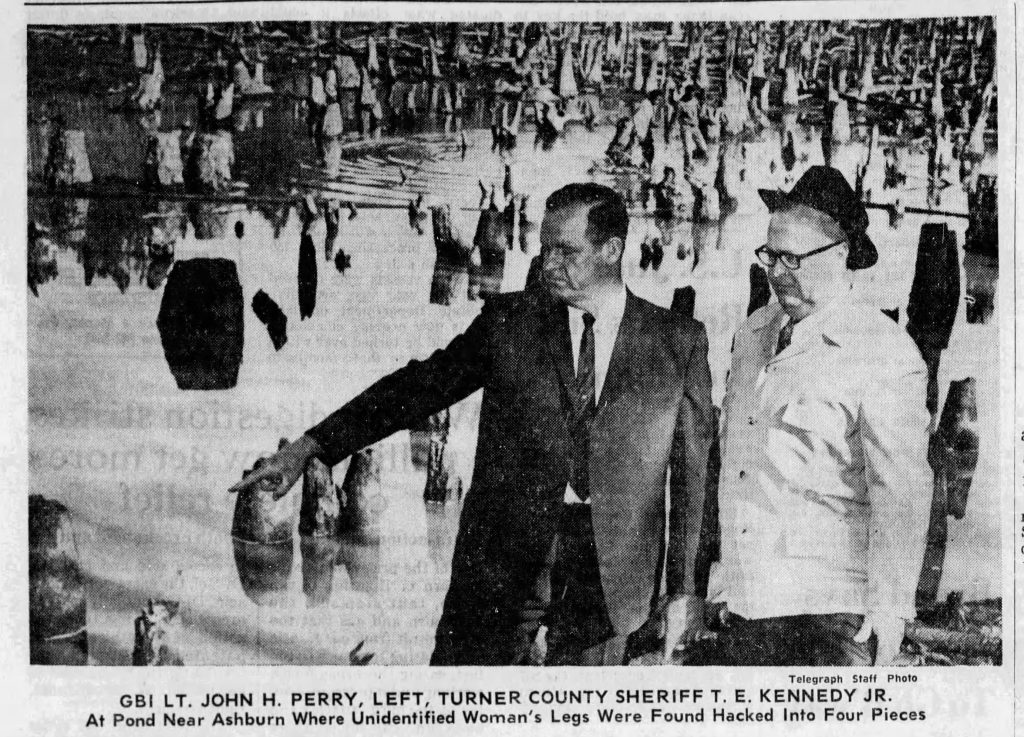
Fishing Date’s Deadly Discovery
On November 28, 1968, readers of The Wiregrass Farmer were met with a shocking headline splashed across the front page: “Who Left Severed Body in Pond?” The story described the gruesome discovery of a woman’s dismembered remains floating in a quiet farm pond just outside of Ashburn, Georgia, near the community of Coverdale. Remembered as the “Lady in the Lake,” this true crime mystery is one for the books.
A fisherman, Edgar Cravey, and his girlfriend at the time first spotted what appeared to be part of a human leg near the pond’s spillway. Some citizens have said that the story of the legs was not originally believed when first reported due to the extracurricular vices Mr. Cravey partook in frequently. However, when Sheriff T.E. Kennedy and deputies arrived, they uncovered even more disturbing evidence. A leg and foot, partly wrapped in plastic sheeting, lay submerged about twenty feet from the shore. Investigators determined that both legs had been severed at the hips and again below the knees, likely with a heavy instrument such as an axe or meat cleaver.
The remains were quickly sent to the State Crime Laboratory in Atlanta, while local authorities began the grim process of draining the pond in search of additional body parts or the murder weapon. Hundreds of residents crowded the scene, anxious for answers. But when the pond finally emptied, little more was found.
No Clues, Only Questions
By December 5, the case had grown colder. The Wiregrass Farmer ran the headline “No Clues to Brutal Death” and reported that the investigation had stalled. Sheriff Kennedy admitted that the victim remained unidentified and that law enforcement may have reached a “dead end.”
A woman’s pocketbook discovered in Crisp County initially raised hopes of a lead, but it was quickly ruled out. Every possible missing-person case from the weekend of November 23 had been traced and dismissed. The State Crime Laboratory added that without more of the body, it could provide little information to move the case forward.
For Turner County residents, the mystery deepened. A brutal murder had occurred in their community, but the victim’s identity – and the person responsible – remained unknown.
All that from a pair of legs? The crime lab gives a clear description of the victim.
Two weeks later, on December 19, investigators finally had something new. The paper’s headline read: “Crime Lab Describes Massacred Woman.”
The Crime Lab’s final report gave the first clear description of the victim: a white female, 25 to 30 years old, about 5’3” tall, weighing roughly 130 pounds, with blonde or light brown hair. She had Type A blood and a distinctive scar on her right leg, about eight and a half inches above the foot.
Sheriff Kennedy and GBI Lt. Harris Perry followed every possible lead, checking missing persons from across Georgia. At least seven women who fit the description were investigated, but one by one, each was accounted for. Meanwhile, the Turner County community waited uneasily, hoping for closure but bracing for the possibility that answers might never come.
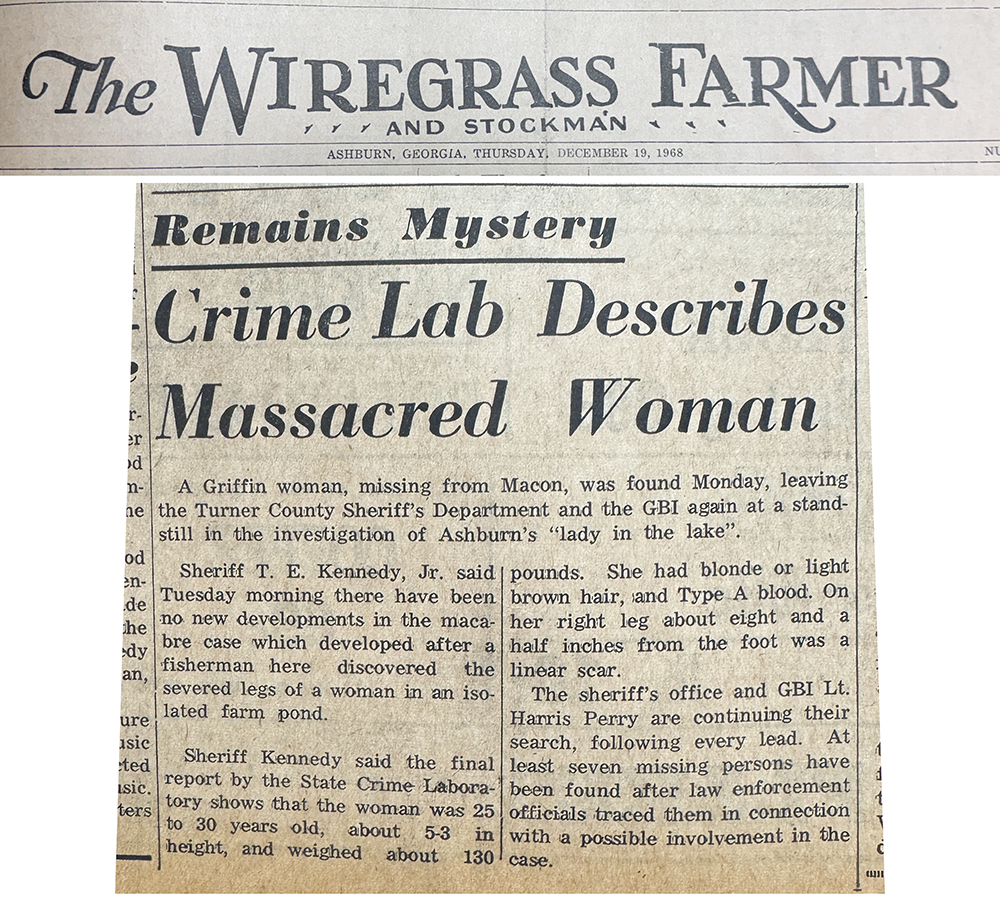
Visit the Turner County Project Store and wear your hometown pride today!

Ashburn’s Unsolved Mystery
The “lady in the lake” case, as it became known, lingered as one of Turner County’s darkest mysteries. Despite intensive searches, forensic examinations, and countless leads, the woman’s identity was never revealed – and her killer was never brought to justice. Some in town claim that it was a plane that flew and just randomly dropped the body parts. That seems to be the overwhelming belief when asking anyone nowadays.
Even decades later, the headlines from The Wiregrass Farmer serve as a haunting reminder of a crime that left more questions than answers. For those who lived through it, including men like the Perry Brothers – Charles, Paul, and Edgar – who later shared their memories in an oral history interview, the case remains a chilling piece of local history.
Who was the young woman? Why was her life cut short with such brutality? And who was responsible for leaving her in that quiet Ashburn pond?
The questions remain unanswered.
In 2003, Shelley Zorn and Gail Walls interviewed the three Perry brothers: Charles Perry, Paul Perry, and Edgar Perry. One of the topics that was discussed was the “Lady in the Lake.” Click to listen to this small clip as they share their memories and perspectives on this chilling event that shook Turner County.
Clip transcription
Shelley: We wanted to ask about what we’ve heard about the leg floating in the pond. There was two legs?
Charles: Two legs. It was a female legs. A man and his girlfriend were out fishing. They saw them floating and they came back to town. T.E. Kennedy was a sheriff. Daddy was a coroner. We went out there and brought the legs back to town. They were severed at the groin area and in the knee, so there were four pieces.
Shelley: Four pieces.
Charles: The medical examiner came up out there, [unclear]. He looked at them. He got a blood sample, and he said, “Charles, I think we can eliminate suicide.”
Gail: That’s a good one.
Charles: The last time Buddy [T.E. Kennedy] mentioned it to me, there had been over 400 inquiries about that lady that determined that she was white, she was white, she was redhead, she was well-groomed, and the fact she kept her leg shaved.
Edgar: 20 or 30 years of age?
Shelley: They could tell all of that?
Charles: Yeah. Nowadays…
Shelley: Right. Think what they could tell now.
Charles: The legs were transported to the forensic lab in Atlanta.
Edgar: Where they still are.
Charles: And it was in a pond that you either were lost or you knew where you were going when you got there.
Shelley: Because it was so far out.
Charles: Because it was so, so hidden.
Gail: Or you were taken there by somebody else.
Charles: Yeah, and as I recall, they think that they were, that just the legs were taken there. They drained the pond and found nothing else.
Paul: And they even thought possibility they had been flown over in a small plane and dropped them.
Shelley: And just didn’t know where they were dropping them, just knew they were dropping them in the boonies. That’s what I have heard, that maybe they were in bags or something?
Charles: They were plastic.
Shelley: So you think maybe somebody killed this person and did this with all the different parts?
Unknown: *mumbling*
Shelley: Well, I know that. Smarty.
Charles: I hope they killed them before they severed their legs.
Shelley: Well, what I’m saying is killed them and then maybe dropped different parts, different places.
Charles: Yeah, because a few years after that, let’s see, I was in Minnesota. Daddy called me or wrote and told me about it. They found some body parts scattered all the way down Highway 82. They found a head and a torso and then some legs or something back in ’62, ’63, ’64, somewhere in that time frame.
Shelley: When were these legs found? What, ’60, ’70s?
Charles: I’d have to go look back and see. We can pull the file.
Paul: It’s been since I’ve been back here. So it’s been in the late ’60s, early ’70s.
Charles: But y’all talking has helped jog our memory on some things. Because I would have never thought about the legs. But we’ve got a file around here somewhere on that thing. I remember she had a scar, I don’t know if it was the right or left leg. And they determined that she was, as I say, she wore high-heeled shoes a lot. Her toenails were manicured. She was a lady of class. She was not a tramp, by any means.
Below are a few clippings from other Georgia newspapers. One, the Macon Telegraph, provided a great photo from the scene (although not graphic).
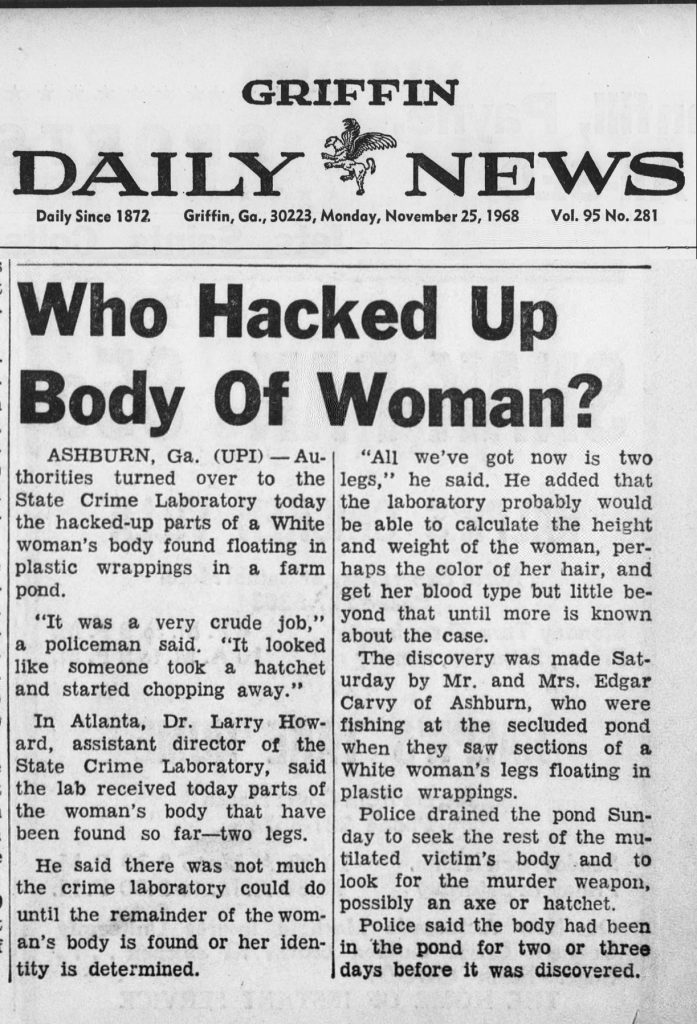
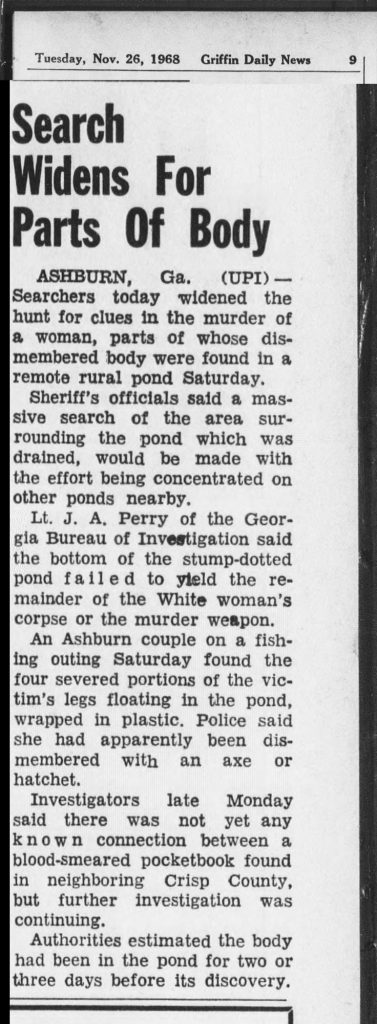

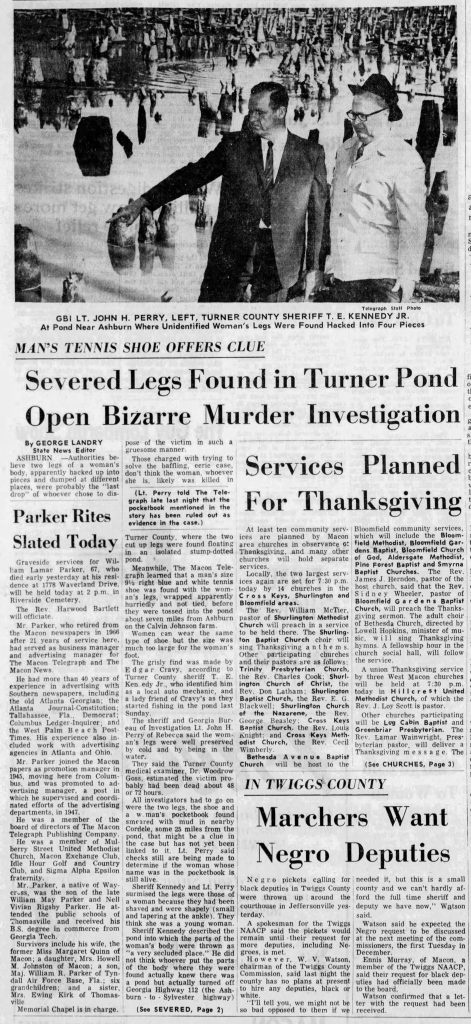
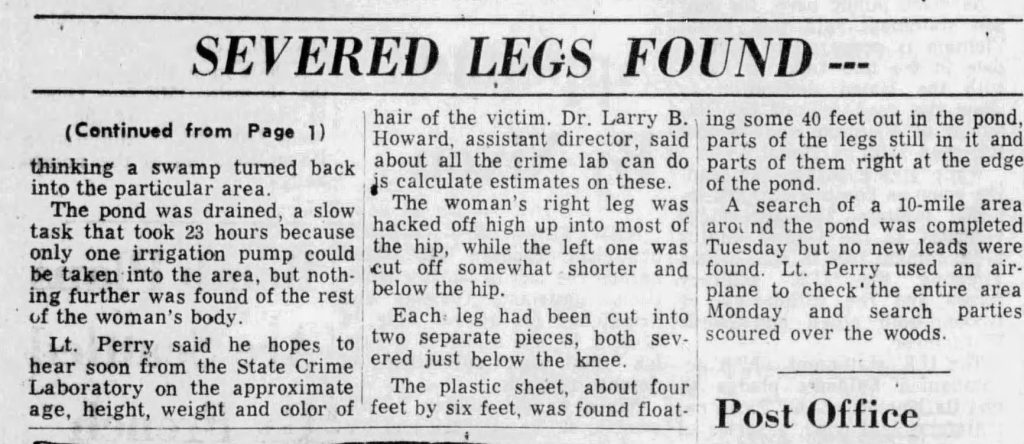

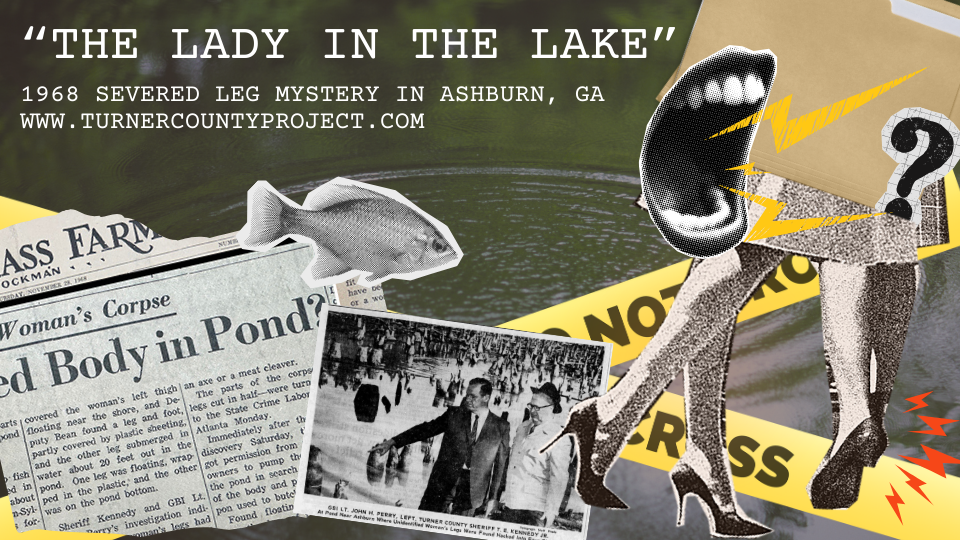
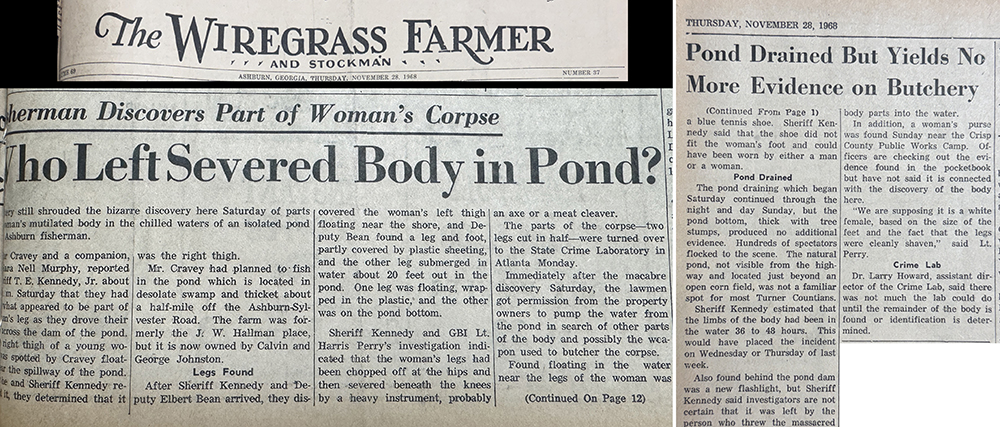
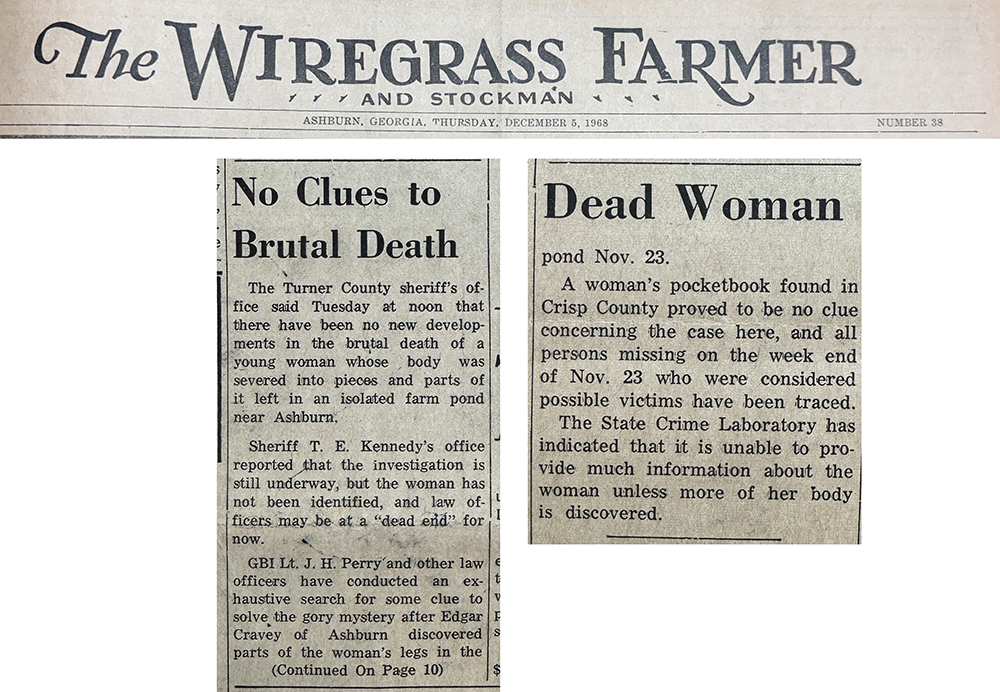


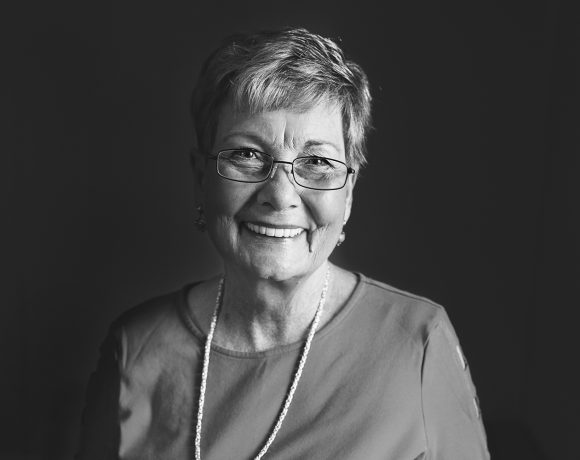
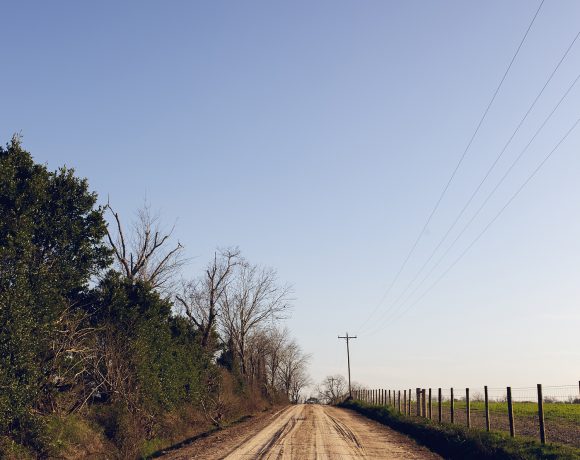
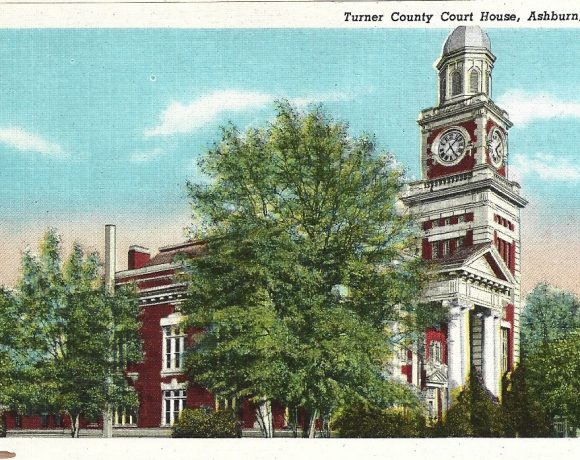
Leave a Reply